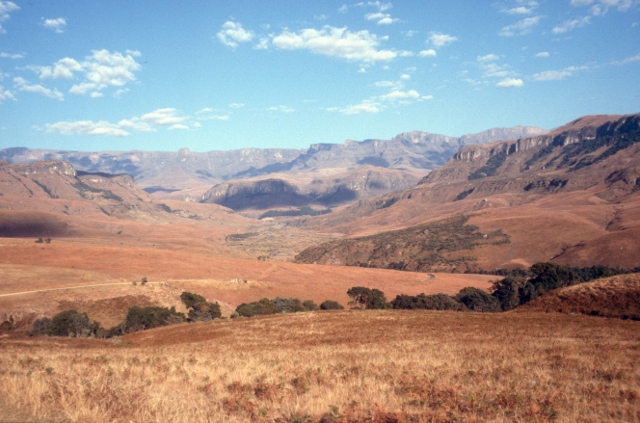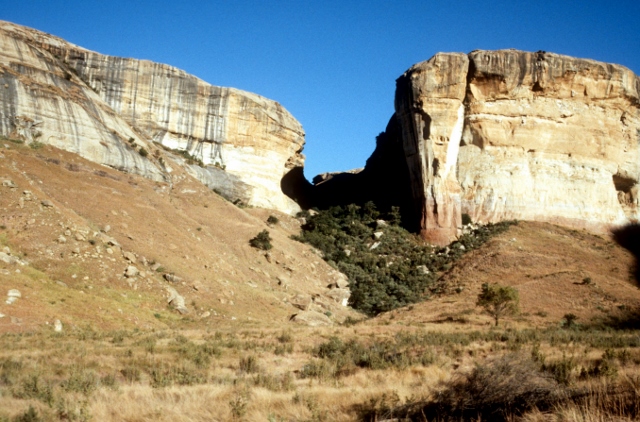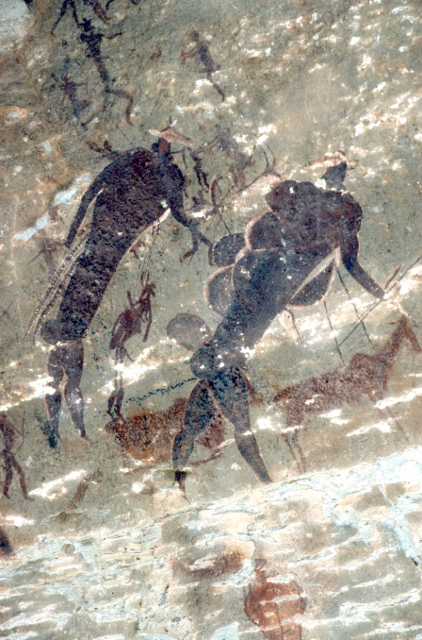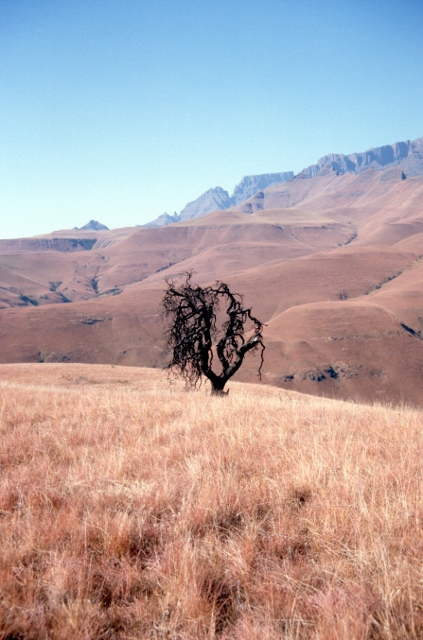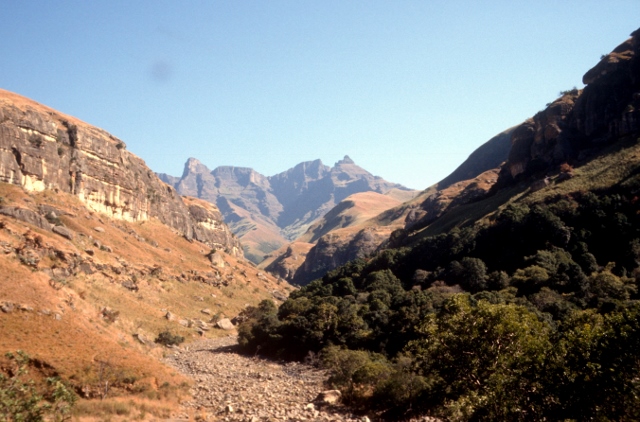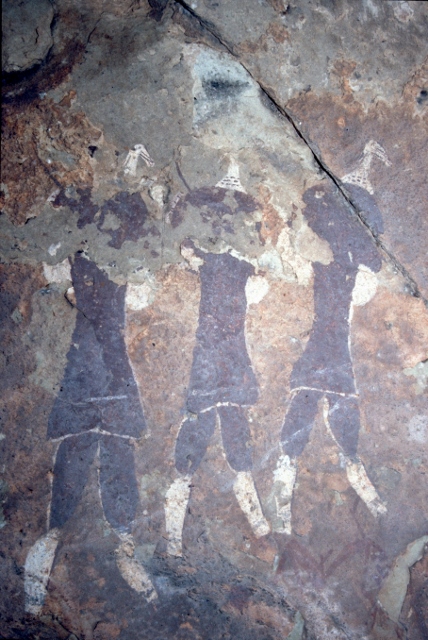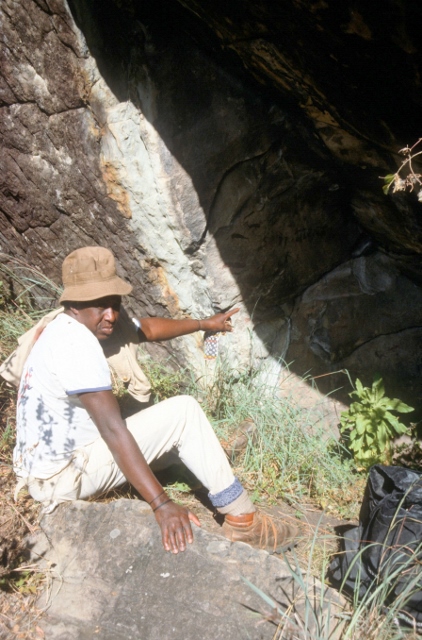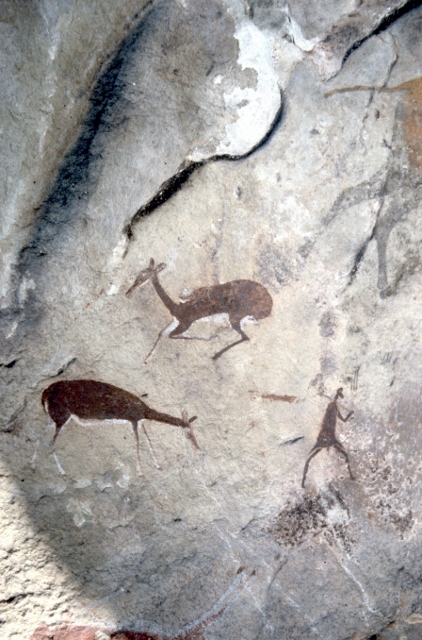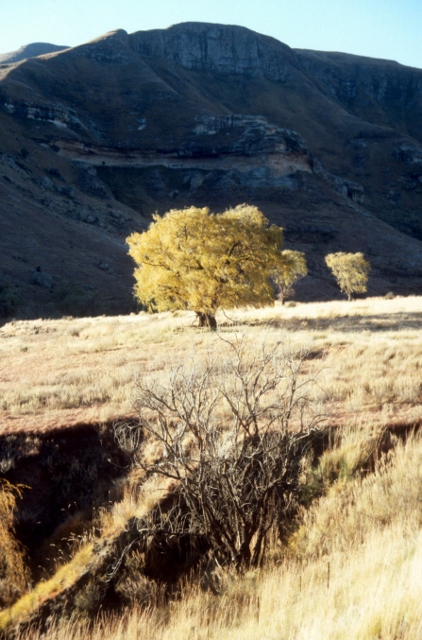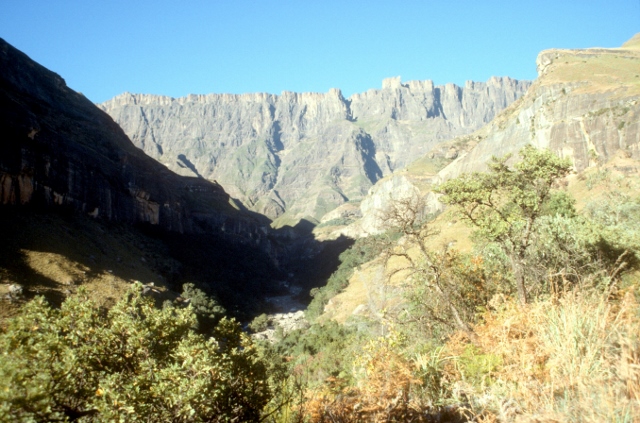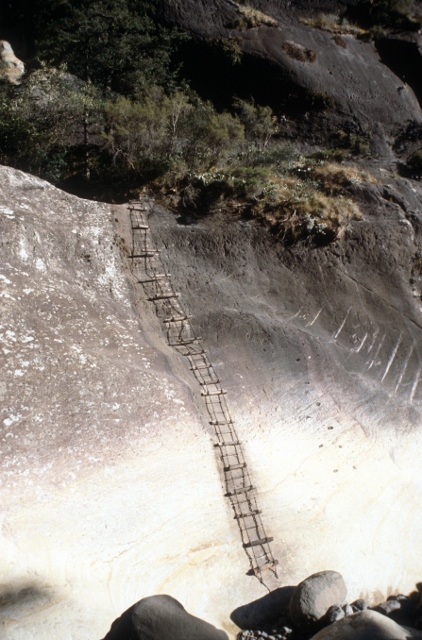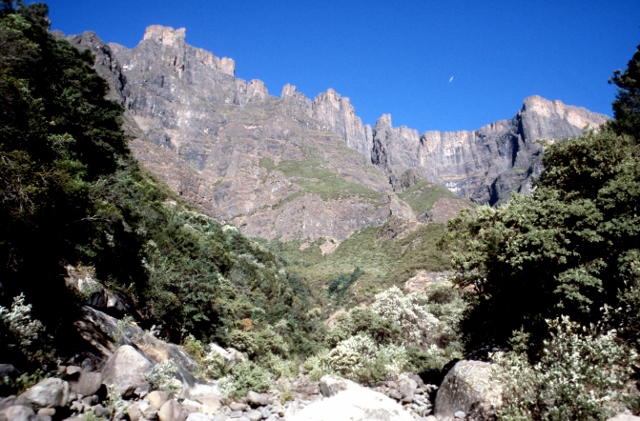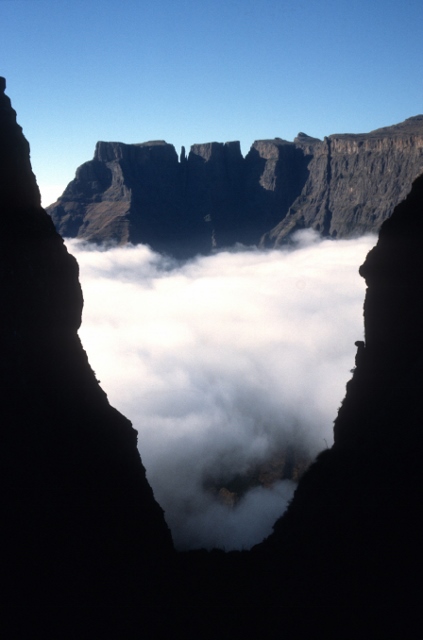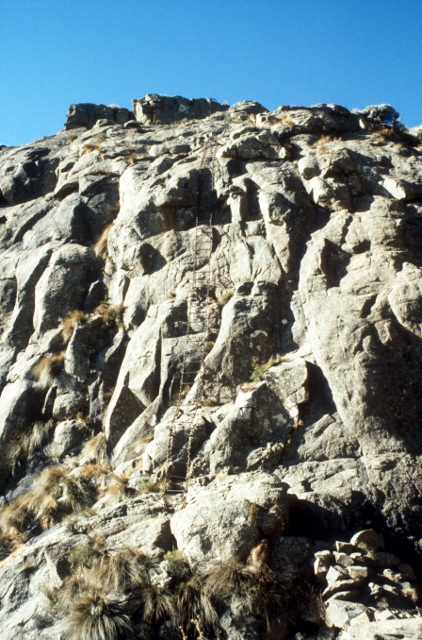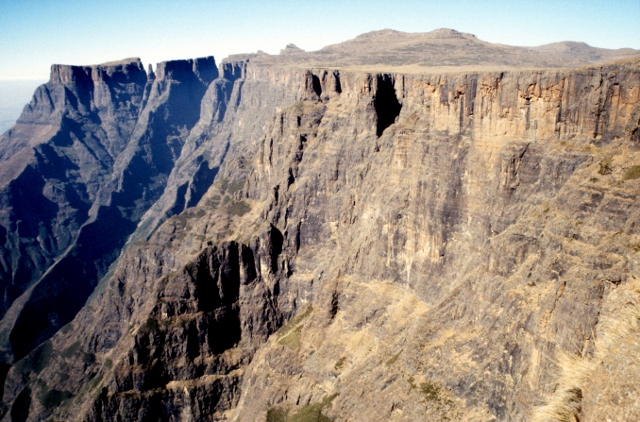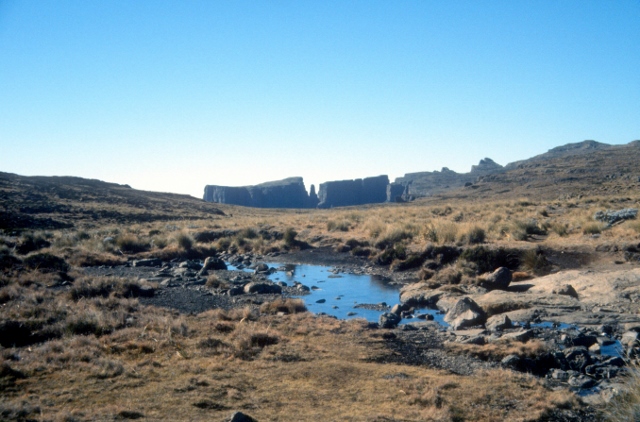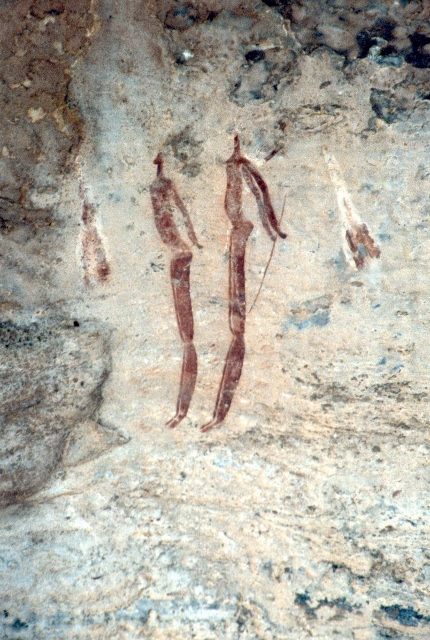May 21st – Giant Castle National Park
Having had the Drakensberg in clear view for the last few days, it was time to explore in more detail. Not in the least, because the lower part of the Drakensberg consists of sandstones, some of them cavernous, in which Bushmen – the San people, more properly – have left their paintings.
I had booked a room in a hotel in the Giant Castle National Park. Unlike in Zimbabwe and Namibia, and other parts of South Africa, visiting rock paintings here is not a matter of turning up and finding the caves, but more of turning up in time for the next tour. So I joined the tour to the so-called Main Caves, together with a group of eight others and a guide. The walk to the caves was an easy half-an-hour affair, with nearly the entire path laid out with cement tiles, and steps wherever it became a little steeper. This is the highly-sophisticated and developed South Africa of the white minority again – and indeed, only the guide was black, the tourists were all whites.
At the cave, the guide opened the fence – these caves are fenced off! – and switched on a tape recorder with commentary on the paintings. And then let us explore the paintings by ourselves. It is claimed that the Drakensberg contains something like 40% of all San rock paintings in South Africa, and here it shows. There is a large collection on the walls of the two separate caves we visited, and also on the occasional large, loose boulders, in a variety of colours, although weathering has affected some of the images. Unfortunately, the photos I took are also not that good. There are more photos here, for the real enthusiasts.



The hotel I was staying in was more of the holiday resort type, which kept its customers entertained with activities from morning to evening. Not my cup of tea, so I spent the time after dinner in the bar, talking to the hotel staff, the bar tenders and the waiters, all Zulu people. Their solution for the future of South Africa was quite shocking, actually. They bluntly stated – when there was nobody else in the room – that change will only come through war, and they would fight for power, and don’t share it. Not with the whites, and not with the ANC either. And they justify this by the fact that it has always been this way, the people of South Africa have always fought in order to get what they wanted. End of story. Quite frightening, to be honest, in a time that people try to come to a negotiated solution between the various interest groups in this country. The conversation abruptly ended when the video showing next door was finished, and the other guests were pouring into the bar.


For the next morning I had signed up for another tour, to Battle Cave, the other main rock painting site in the Giant Castle area. This time there was only one other couple in the group besides myself, and a guide. It took us a leisurely two hours to reach the cave, an easy, mostly flat walk along the river, with the spectacular Drakensberg peaks to one side. And a fabulous gallery of rock paintings at the end, these are perhaps some of the best paintings I have seen so far. And it is obvious why this one is called Battle Cave. More photos here.
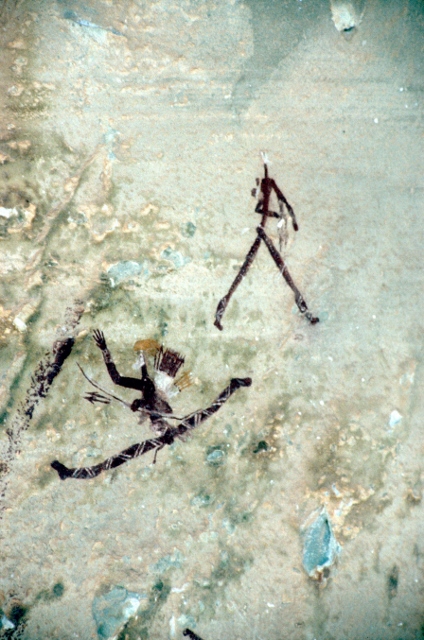
May 23rd – Cathedral Peak
High up in the next valley north of Giant Castle is the Cathedral Peak Hotel, well below the 3000 m high mountain top of the same name. From here I was going to find the Sebaayeni cave, in the upper ranges of the Ndedema Gorge – also called the valley of the Bushmen, on account of the many San rock paintings in a number of caves along the gorge. Luckily, I didn’t have to find the Sebaayeni cave all by myself: I had been assigned a guide, Johannes, who – even better! – was also prepared to carry my backpack. Given that we were looking at an eight hour round trip, a pleasant surprise indeed.
Although the rock paintings were the day’s objective, the walk itself was already more than worth the effort. Like earlier in the Giant castle National Park there are fabulous views over the high peaks of the Drakensberg, whilst the lower ranges, where we are walking, are brilliantly red and brown in autumn colours. Not a lot of trees here, anymore, we are obviously much higher, but we do come across the occasional protea, South Africa’s national tree. The last part of the walk was a long descent into the Ndedema River valley, from where it is a short climb up to the cave.
Sebaayeni Cave is reckoned to contain some 1000 different paintings, by far the largest gallery in the gorge. And it is great to wander around here, on your own – Johannes had stayed down at the river – and admire the ancient rock art, however ancient it may be. In South Africa, like in Zimbabwe, there is not a whole lot of interest in this part of the cultural heritage, and thus not a lot of research, either. These paintings maybe 3,000 years old, or perhaps they are only a hundred years old, they are difficult to date, even if you show interest in the subject. I find them fabulous, whether depicting large animals, or hunting scenes, of shamanistic figures. More photos of the cave here.
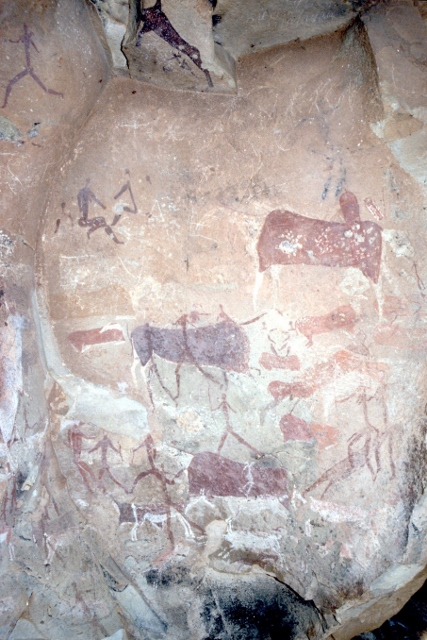
Back down at the river, Johannes had made some tea, and we had lunch, before we returned to the car, and to the hotel.
The next morning I teamed up with Johannes again, for a few hour’s walk to a rock paintings site nearer the hotel, the Zeni rockface. Here the images were more domestic, and more monochromatic than those of the day before, but once again very vivid, and great detail: a wonderful gallery.
May 24th – Royal Natal National Park
The South African side of the Drakensberg is dotted with national parks, and the Royal Natal National Park is yet another one, further north from the Cathedral Peak area. I had gone here to walk to the so-called Amphitheatre, with 5 km wide and some 1300 m high perhaps one of the most impressive cliff faces on earth. I had read about a walk to the base of the Amphitheatre, a good half a day along the Tugela River, with at the end a gorge and a real tunnel to pass! Since this appeared to be a very popular hike, I had decided to start early, to try to beat the crowds, and indeed, at seven in the morning there was nobody.
The first one-an-a-half hours were easy, along the river and occasionally through a forest. Then the path disappeared in the river bed, mostly dry as there wasn’t a lot of water at this time of the year. However, the further upstream, the narrower the river, and the more difficult progress became, stumbling from boulder to boulder. Finally I arrived at the ‘tunnel’, in effect a narrow passage, perhaps two to three meters wide, in between overhanging rocks, so that often the sky was no longer visible. Of course, such a narrow passage wasn’t dry anymore, and although boulder-hopping I got a long way, in the end I returned to the beginning of the tunnel, to avoid wet feet. This being South Africa, there is an alternative, of course. A real chain ladder allowed you to up a steep rock face, and through a joint in the rocks, helped by tree trunks and steel cables and metal pins I managed to bypass the tunnel altogether, and descent on the other end. Into the Amphitheatre!
Difficult to describe, this Amphitheatre. You see before you a mountain of stone towering up, hundreds and hundreds of meters, up and up. Only near the top there are some joints and fractures, where in rainier days no doubt several rivers cascade down, but for the rest it is just one, immense vertical wall. And me, all alone, in front of it.
On the way back, up the steep track and down the steel cables and the chain ladder again, and then back on the path along the river. Where I met all the other walkers, who had left later, more than 30 of them, in small groups or in couples, still on their way to the gorge. There is a funny sort a camaraderie, they all greet you enthusiastically, they all want to know how far they still have to go, and was it nice? Silly of course, but never mind.
After lunch I went to see more rock paintings. The booklet I had talked about a 45 minute walk one-way, but after about 15 minutes the path ended, in the Sigubudu Cave. Which was adorned with great paintings of elands, considered sacred animals by the San people. I still find these pictures fascinating.

May 25th – Witsieshoek Mountain Resort
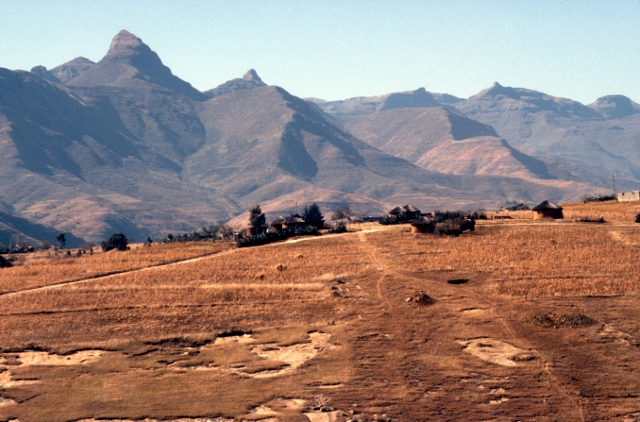
Witsieshoek was not in the original planning. But in the last few days I had been told that close to the Witsieshoek Mountain Resort there is a way to climb to the top of the Drakensberg plateau – so looking down into the Amphitheatre! – and back in one day. With a mostly horizontal geology, the base of the Drakensberg is sandstones, including the cavernous layers that contain the caves with San painting. And on top of the sands is an over 1300 meter thick layer of basalts, the vertical wall of the Amphitheatre. Having looked up at the basalt peaks for the past week or so, I though it would be nice to also get to the top.
The Mountain Resort is petty high up already, at some 2200 meters, in between the basalts, and from here it is but a short drive to the parking place from where the path up the mountains starts. It was foggy when I set out, but soon, zig-zagging upwards, I reached above the mist, which provided a whole new experience: Drakensberg mountains sticking out of this white blanket of clouds. As if you are in a plane, really!
The path is not for the faint-hearted. Part of it leads past one of the high peaks, the Sentinel, leaving you to carefully shuffle forward between a sheer wall of rock on one side, and the abyss on the other. Only to end up at a chain ladder, with a hundred rungs, or so, that takes you up – vertically up! – one of the main basalt layers.
And then you are on the plateau. Suddenly you see all these peaks, the ones I was looking up to the day before from the bottom of the Amphitheatre, now from behind. And I can look through the joints and fractures, down to where I had been the day before; I could see the gorge, and the tunnel, and the river, the path I had followed. Quite spectacular!
I spent another few hours, walking the plateau, occasionally encroaching the escarpment, holding my breath every time I bent forward to look down. The plateau itself is grassy, with a few streams meandering through. As we are at around 3000 meters, and the winter is nearing, some of the water had frozen over already; weird, touching ice in May, after having spent almost two months in the heat of Southern Africa, in the desert even. Yet I came to the conclusion that this was probably the most spectacular scenery I have seen during this entire trip, it beats the Namib Desert, it beats Victoria Falls from a few years ago, or the Tanzanian game parks of even longer ago. Really. How privileged I am that I could do this, and could do this all on my own, without any other tourists around.
Except that I still have to descent again, using that scary chain ladder. All on my own, too!
May 28th – Lesotho
The last few days of my trip I spent in Lesotho, with friends. On the drive here I passed the Golden Gate Highland National Park, another of the Drakensberg NPs. More scenery, a valley through massive sandstone outcrops on both sides. But after the scenery from the top of the Drakensberg, this is small beer.
In Lesotho itself I don’t do a lot. There is some political unrest, so we keep a low profile, don’t go out much. I do get to see the rock paintings at Ha Khotso, another San site. But having seen so many excellent examples already, in the past few days, these images look a bit more fainted, a bit of an overkill, too. Or maybe I am ready to go home, maybe I am mentally preparing myself for the end of this trip.
In a few days I drop my rental car off at the airport of Johannesburg, and I fly back to London. After some eight weeks of travelling. But what a trip it has been!
